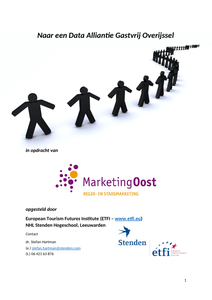Dit rapport is een aanvulling op de de toekomstvisie van het NBTC betreffende het inkomend toerisme in Nederland. Als aanvullende input voor genoemde toekomstvisie heeft het NBTC aan ETFI gevraagd om met behulp van een scenariostudie te komen tot (betere) ramingen van de omvang van het internationaal verblijfsbezoek aan Nederland richting 2030. Een dergelijke studie kan helpen bij het identificeren van onzekerheden en het bepalen van bandbreedtes. De doelstelling was als volgt omschreven: Op interactieve wijze een aantal toekomstscenario’s ontwikkelen die helpen bij het identificeren van onzekerheden en het bepalen van bandbreedtes waarbinnen het internationaal verblijfsbezoek zich op de (middel)lange termijn kan gaan ontwikkelen.
DOCUMENT

Video about Brabant Remembers Living History Augmented Reality app for NBTC Digital Innovations.
YOUTUBE

Video about the Secret Marquise experience at Markiezenhof Bergen op Zoom for NBTC Digital Innovations.
YOUTUBE

Contributors: Hotelschool The Hague HZ/ Kenniscentrum Kusttoerisme Breda University of Applied Sciences Centre of Expertise leisure, tourism & hospitality (CELTH) Marketing Drenthe Stichting Eilandmarketing Schouwen Duiveland Marketing Oost NBTC.
DOCUMENT

DOCUMENT
DOCUMENT

The aim of this QSR 2022 on tourism is to make an attempt to assess available information about the tourism industry from three countries and various sources and present it in a comprehensive manner. We, thereby, describe common features of regional tourism structures, as well as differences, and we present some of the identified data incompatibilities (sections 2.2 and 2.3). The recommendations in section 3 present avenues along which data collection and monitoring can be improved, inspired by a set of key forces driving change intourism that stakeholders should be prepared for (section 2.4).
MULTIFILE
![Tourism [Wadden Sea Quality Status Report]](https://publinova-harvester-content-prod.s3.amazonaws.com/thumbnails/files/previews/pdf/20250506134122033770.20-20Wadden20Sea20Quality20Status20Report20-20Tourism-thumbnail-400x300.png)
Dit project draagt bij aan het versterken van “de kennisketen van de Drentse vrijetijdseconomie”. De kennisketen wordt onder meer gevormd door kennisinstellingen, brancheverenigingen, overheden, bancaire instellingen, ondernemers en loopt van vergaren en verzamelen van data en kennis tot het ontsluiten ervan naar gebruikers. Het project beoogd de volgende doelen: Inventarisatie van het data-aanbod in Drenthe bij diverse partijen Inventarisatie van hoe partijen in het domein VTE de data-behoefte prioriteren. Input leveren voor de verdere uitbouw van de kennisketen in de context van Leisure Valley Drenthe.
DOCUMENT

Dit project poogt een bijdrage te leveren aan het versterken van “de kennisketen van de gastvrijheidseconomie” middels de volgende projectdoelstellingen: • SWOT-analyse van huidige situatie, vanuit verschillende stakeholderperspectieven: kijkend vanuit de ontwikkelopgaves die men ziet, aan welke data over de customer journey is behoefte (inventarisatie)? Wat zijn de bijbehorende sterktes, zwaktes, kansen en bedreigingen (analyse)? • Versterken van de kennisketen via: hoe kunnen we kennisketen versterken met nieuwe technieken en door slim organiseren? • Een overzicht van strategische opties: welke strategische opties zijn er om 1.) sterktes te benutten om kansen te pakken en bedreigingen af te wenden en 2.) zwaktes op te lossen door kansen te pakken en gevaren te voorkomen die met bedreigingen meekomen • Input leveren voor 2.0 versie van het manifest van Gastvrij Overijssel en de beoogde oprichting van een “Data Hub” (waarvoor nog geen officiële werktitel) In de opvolgende hoofdstukken en paragrafen gaan we in op de aanpak (hoofdstuk 2) en de uitkomsten (hoofdstuk 3).
DOCUMENT

Het Our Common Future (OCF) 2.0 project probeert de maatschappij een spiegel voor te houden en te wijzen op bedreigingen, maar ook op de grote kansen die er liggen om een duurzame maatschappij te ontwikkelen. In negentien deelonderwerpen zijn specialisten uit het hele land een maand of vier aan de slag geweest om dit duurzame toekomstbeeld te schetsen en een stappenplan te ontwikkelen om er ook daadwerkelijk te komen. Onderstaand stuk beschrijft één van deze deelonderwerpen. Het is geschreven door dertien specialisten op het gebied van toerisme. Het beschrijft de huidige ontwikkelingen in het toerisme, de bedreigingen, maar vooral de kansen die de Nederlandse toeristische sector heeft om in 2035 te komen tot 100% duurzaam toerisme vanuit en naar Nederland.
DOCUMENT
